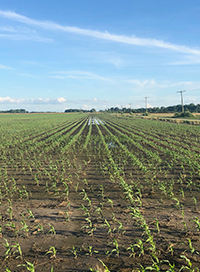 A corn replant decision is never easy. But by combining scouting with yield history and cost/price ranges, you can use sound data and economics to help remove the emotion from the equation.
A corn replant decision is never easy. But by combining scouting with yield history and cost/price ranges, you can use sound data and economics to help remove the emotion from the equation.
The first step is to gather a field's healthy plant counts to determine the potential yield of the existing stand. If plant loss is uniform across the field, you won’t need many sample counts; if plant loss is erratic, take at least three random and representative counts in affected areas to improve your average count. For common 30-inch rows, measure 17 feet 5 inches of row and count only the healthy plants, then calculate your average and multiple by 1,000 to get an estimated population per acre.
If you have a drone, the University of Nebraska offers tips to count or scout stands. Some technology companies such as DroneDeploy, PrecisionHawk, Sentera, and others also offer stand count services to farmers.
Estimated yield potential
There are three pieces of data you need to do the math, according to Bill Wiebold, University of Missouri Extension agronomist:
- yield potential of the sparse stand (a stand density relationship)
- yield potential of replant stand (a planting date relationship)
- cost to replant
"For replanting to make sense, the estimated revenue if you replanted must be greater than the estimated revenue from the sparse stand by an amount large enough to at least cover all costs of replanting," he stresses. "Even if the math indicates replanting, other factors like alternative uses of precious time during spring may result in leaving a sparse stand.”
Bob Nielsen, Purdue University Extension agronomist, has done numerous plant population trials. “Our tests here in Indiana show that the optimum population for corn is a wide range, given today’s quality genetics. You can achieve close to maximum yield from 26,000 to 28,000 plants per acre on the low side, to 35,000 to 36,000 on the high side.”
For example, say your initial target stand was 32,000 to 34,000 plants per acre, and emergence problems show a current stand count of 26,000 to 28,000 plants. “Based on our data, even though you’ve lost 6,000 or so plants per acre, you’re probably still close to maximum yield. So even though you lost 4,000 to 6,000 plants, there’s no economic reason to replant,” explains Nielsen.
Calendar date is vital to calculate the potential yield of the remaining plant population because the percentage of maximum yield drops each week. “It’s easier to decide if it’s not late May and your seed company offers free seed for replanting,” he adds. “But if you’re entering a shorter growing season, planting hybrids in the same field with different maturity schedules—will they mature before frost, or require more dry-down costs? It’s not an easy decision. There are no black and white answers.”
Profitability factors
Calculate your gross revenue potential given the population of the remaining stand, an estimated yield (use field history data) and a corn price at harvest. Use a market advisory service or the futures market (less local basis) to estimate harvest price. Then add up all possible replanting costs. Aside from potential added seed costs, a yield increase from replanting must be sufficient to pay for extra tillage, fuel, labor and herbicide costs.
There’s also potential yield loss from increased susceptibility of late corn to summer pests, diseases or drought. A later crop may also impact harvest and drying costs. Equipment size can cause issues, too, if a large planter doesn’t fit well in replant areas, causing damage or crowding existing crops.
When you compare the net income from replanting and the income from a sparse stand, a positive estimate for replanting must be weighed with current weather outlooks and other demands on your time (planting soybeans, spraying herbicides).
Some university Extension services such as Purdue University and the University of Missouri offer corn replant decision worksheets to aid calculations. In addition, the University of Missouri also has a crop insurance tool updated in May 2019.
Armed with your data, don't forget to check with your crop insurance agent to ensure policy compliance regarding replanting details and important timelines for your area.
If you deem a replant is a sound decision, most agronomists recommend you destroy the original stand and start over. Interseeding directly into an existing corn stand isn’t wise due to plant competition (old versus new plants) trying to share water, nutrients and space. If you use tillage to eliminate the old crop, you’ll need a new herbicide treatment for weed control. In this case, don’t forget all herbicide tolerances in the crop. Check out this University of Missouri recommendation, “Herbicide Options for Killing Failed Corn Stands.”
For more information:
- "Soil temperature and corn emergence,” Pioneer/Corteva
- “Corn stand evaluation and replant considerations,” Pioneer/Corteva
- Corn replant decision tool, Pioneer/Corteva
- “Corn and soybean replant decisions,” University of Missouri
Content provided by DTN/Progressive Farmer
The More You Grow
Find expert insights on agronomics, crop protection, farm operations and more.